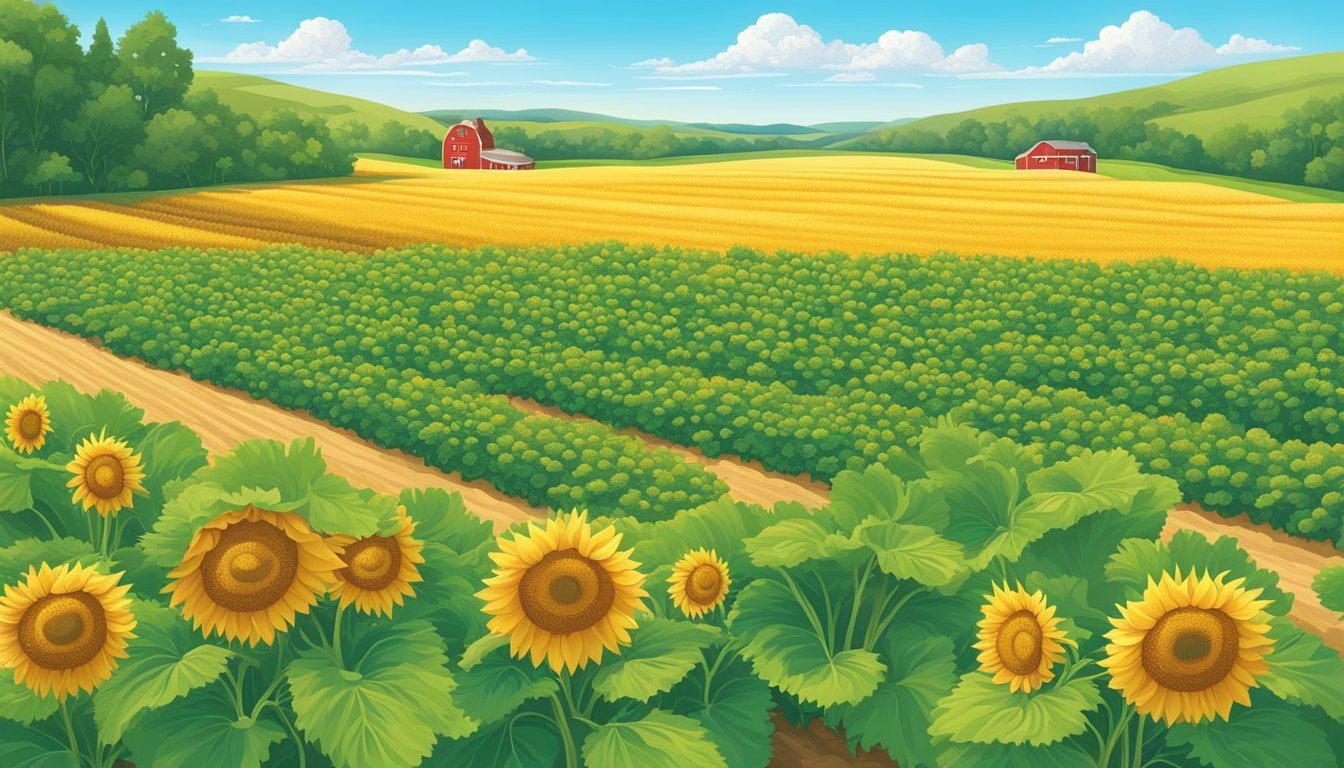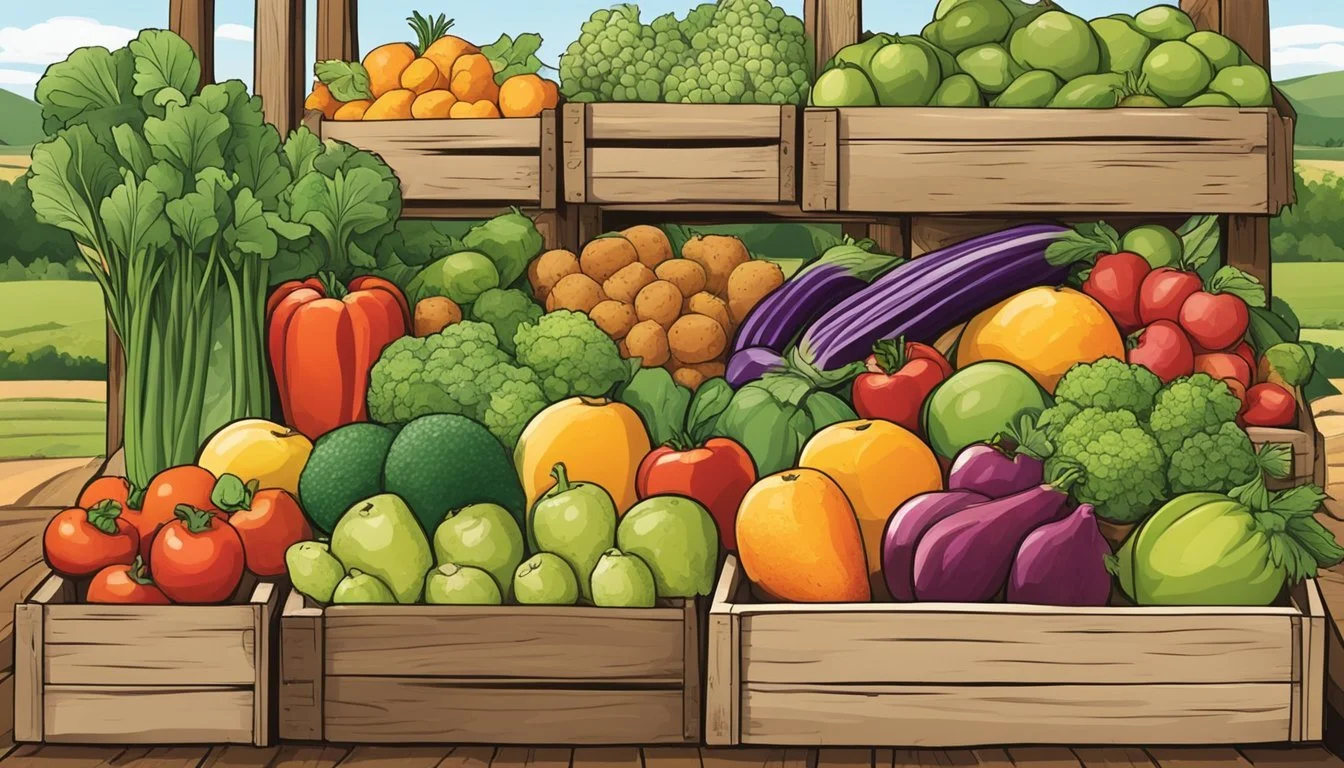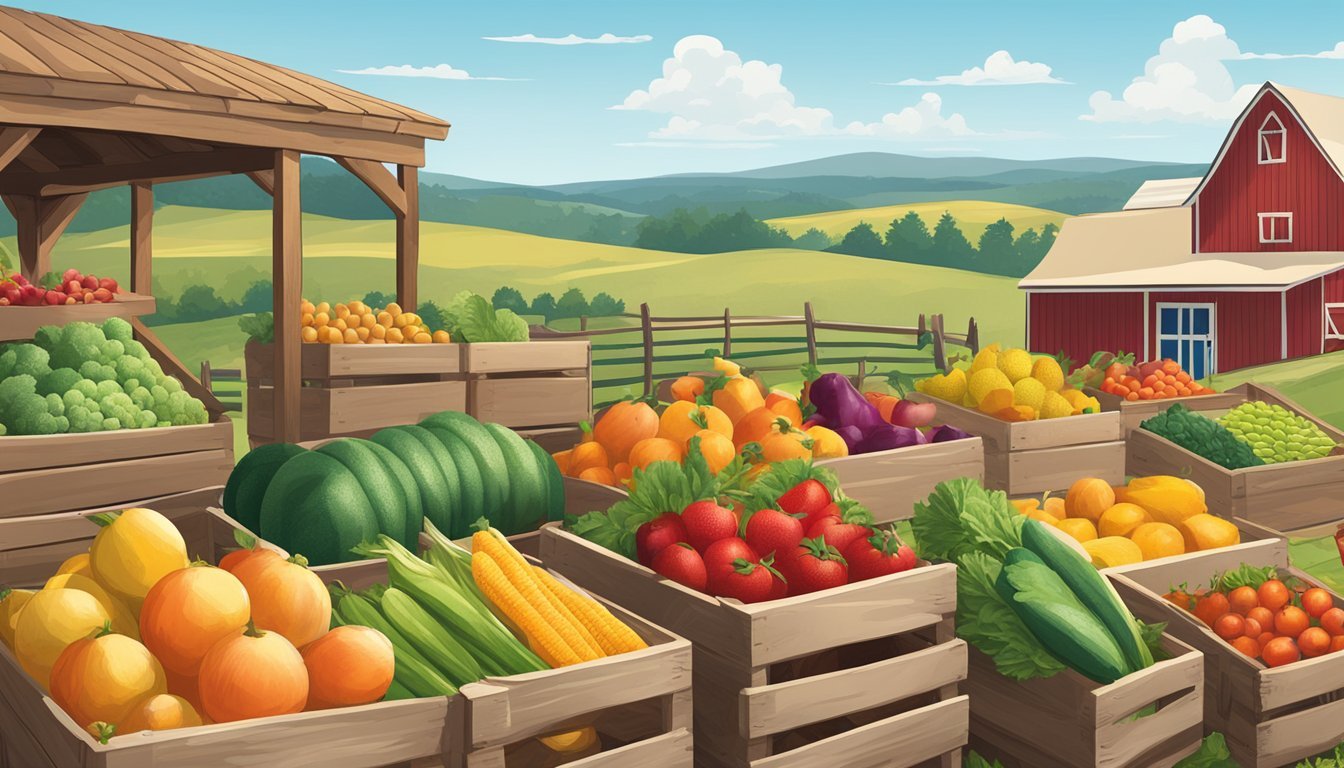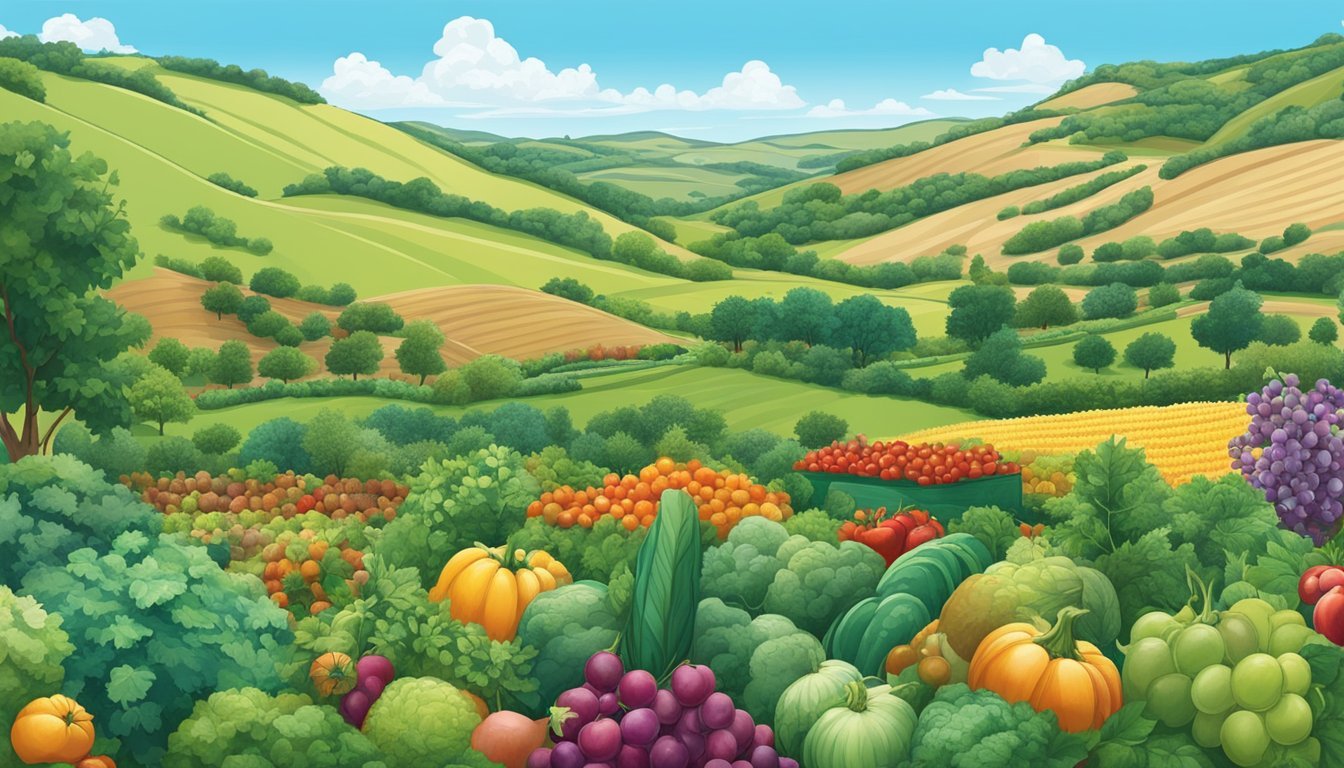South Dakota Seasonal Fruit & Veg Guide
Your Ultimate Shopping Companion
South Dakota offers a refreshing array of seasonal produce that exemplifies the farm to table movement across the state. Much more than mere trends, eating locally and seasonally benefits not only the palate but also the environment and the local economy. With a climate that ranges from cold winters to warm summers, South Dakota’s agricultural output varies throughout the year, providing an opportunity for residents and visitors alike to experience a true taste of the region.
The state’s farming calendar begins with hardy spring vegetables, moves into a bountiful summer harvest, and wraps up with autumnal produce that leads into the preservation efforts for the colder months. Each season brings its banner crops, with summer heralding the likes of tomatoes and sweet corn, while fall ushers in a harvest of pumpkins and root vegetables. The cyclical nature of this availability encourages not only seasonal eating but also supports sustainable agricultural practices.
For the discerning diner or the home cook, understanding what is in season is key to enjoying the freshest possible ingredients. South Dakota's seasonal selection includes a diverse range of fruits and vegetables that can inspire menus and eating habits. This knowledge connects consumers with the rhythm of their local food systems, providing an appreciation for the agricultural process and the changing seasons that is grounded in the landscape of the state.
What’s in Season in South Dakota Right Now?
Understanding South Dakota's Growing Climate
South Dakota's agriculture is greatly influenced by its climate and soil conditions, which in turn impact pest and disease management strategies essential for a successful harvest.
Climate and Seasonality
South Dakota experiences a continental climate, characterized by four distinct seasons. Summers tend to be hot and sometimes humid, while winters are cold with substantial snowfall. This variation affects the growing season, typically:
Spring: April - June; risk of late frosts
Summer: July - August; peak growing season for many crops
Fall: September - early November; harvest season, early frost can occur
Winter: November - March; generally not suitable for crop growth
Crop selection and planting schedules must adapt to these seasonal patterns to ensure optimal growth and yield.
Soil and Land Management
The state's soil mainly consists of fertile glacial till and rich loam, which are ideal for agriculture. Key soil types include:
Silty Clay Loam: Retains moisture well, suited for row crops.
Sandy Loam: Good drainage, often used for root vegetables.
Soil conservation and land management practices are critical in South Dakota. Such practices include no-till farming to prevent erosion and rotating crops to maintain soil health and fertility.
Pests and Disease Management
Farmers in South Dakota combat various pests and plant diseases that can vary with the climate and season. Common concerns include:
Corn Rootworm: Insect pest affecting corn crops.
Soybean Aphid: Damages soybean plants.
Rust: A fungal disease that can affect wheat and other grains.
Management strategies such as crop rotation, resistant crop varieties, and the judicious use of pesticides help control these challenges. Integrated pest management (IPM) approaches aim to minimize chemical use while effectively protecting crops.
Seasonal Fruit Guide
This section provides a comprehensive guide to the freshest fruits available in South Dakota throughout the year, focusing on the seasonal peaks for optimal flavor and local sourcing.
Spring Fruit Selection
In the spring, South Dakotans look forward to the arrival of strawberries, which herald the beginning of the fruit season. Typically, they become available in late spring and are a beloved choice for their sweet, juicy flavor.
Summer Fruit Abundance
Summer boasts the greatest variety and abundance of fruits. Cherries kick off the season, quickly followed by raspberries, peaches, plums, and blueberries. These fruits, especially peaches, find their peak during the warmest months, offering vibrant flavor and nutrition.
Summer Fruit Expected Peak Availability Cherries Early to mid-summer Raspberries Mid-summer Peaches Mid to late summer Plums Mid to late summer Blueberries Mid to late summer
Fall Fruit Harvest
As summer wanes, fall brings the harvest of several robust fruits. The apple season begins, with multiple varieties ripening at different times throughout autumn. Meanwhile, vineyards become busy with grape picking, which is essential for both table consumption and South Dakota's wine production.
Winter Fruit Availability
Winter does not offer as many locally grown fruit options due to South Dakota's cold climate. However, certain apple varieties stored from the fall harvest remain available, providing a fresh, crisp option through the colder months.
Seasonal Vegetable Guide
In South Dakota, each season brings a unique set of vegetables that can be planted or harvested. This guide offers a focused look at what vegetables South Dakota growers can expect to work with throughout the year, respecting the state's varied climate conditions.
Spring Vegetable Planting
The onset of spring in South Dakota is marked by the planting of asparagus, lettuce, and spinach. As soon as the soil can be worked, typically in late April, these vegetables are among the first to be sown. Growers can also begin planting peas and kale during this period for a late spring to early summer harvest.
Asparagus: planted once soil thaws
Lettuce: starts in early spring
Spinach: planted in early spring
Peas & Kale: sown as soil thaws, harvested in late spring/early summer
Summer Vegetable Growth
Summer's warm temperatures encourage the growth of a variety of vegetables. Tomatoes, beans, cucumbers (how long do cucumbers last?), and zucchini thrive in these months. South Dakota farmers typically plant these in late spring to avoid frost, and harvest throughout the summer. Corn is also a staple crop, with planting starting when the soil reaches an optimal temperature, leading to midsummer harvests.
Tomatoes & Cucumbers: planted post-frost, harvested throughout summer
Corn & Zucchini: planted in warm soil, harvested in midsummer
Fall Vegetable Preparation
During the fall season, South Dakota's producers harvest potatoes and pumpkins, which are planted in the summer months. At the same time, they prepare for late-season vegetables such as broccoli and cabbage. Kale and spinach can experience a second harvest before frost if they were planted in late summer.
Potatoes & Pumpkins: harvested, planted in summer
Broccoli & Cabbage: prepared for late season
Kale & Spinach: potential second harvest in late fall
Winter Vegetable Picks
Winter in South Dakota limits fresh vegetable growth; however, certain root vegetables and sweet potatoes are harvested in late fall and can be stored for use throughout the winter. Green beans, canned or frozen, are also commonly used during this season as they preserve well. Growers use this time to plan for the next year's plantings.
Root Vegetables & Sweet Potatoes: harvested in late fall, stored for winter
Green Beans: preserved, consumed in winter
Optimal Harvest Times in South Dakota
Understanding the optimal harvest times for produce in South Dakota can significantly impact the freshness and flavor of fruits and vegetables. This guide helps identify the best times to gather various crops throughout the seasons.
Harvest Calendar Overview
The harvest calendar for South Dakota is typically broken into four distinct periods correlating with the spring, summer, fall, and winter seasons. Each season brings its own set of produce ready to be harvested.
Spring: Asparagus, lettuce, and peas
Summer: Berries, cucumbers, peppers, tomatoes, and melons
Fall: Apples, squash, and pumpkins
Winter: Cold storage of root vegetables like carrots and potatoes
Peak Harvest Timing
Harvest times can vary based on weather conditions and specific growing regions within the state. However, there are general windows when one can expect certain produce to be at its peak:
Spring (April to June): Asparagus and lettuce are among the first to be harvested, typically peaking in late spring.
Summer (July to September): This is a busy season with tomatoes, cucumbers, and melons reaching their optimal ripeness.
Fall (October to November): Fall ushers in the time for apples, squash, and pumpkins, with apple varieties being especially abundant.
Winter (December to March): Harvesting slows down; however, stored produce like beets and potatoes remain available.
End-of-Season Harvesting
Towards the end of each growing season, there is often a rush to harvest the remaining produce before the weather turns unfavorable.
Late Summer: Corn and beans are gathered before the first frost.
Late Fall: Hardy vegetables like Brussels sprouts and kale can withstand colder temperatures and are often the last fresh vegetables available.
Early Winter: Late apple varieties and root vegetables stored from fall harvests ensure a supply through the colder months.
Preserving Flavor and Nutrition
When fruits and vegetables are harvested in South Dakota, their flavor and nutritional value are at their peak. Proper post-harvest handling, storage, and preservation methods are crucial in retaining these qualities until consumption.
Post-Harvest Handling
Immediately after harvest, the vital step of cooling fruits and veggies helps to slow down the deterioration process. For example, leafy greens should be cooled rapidly to retain their crispness and nutritional content. Careful handling is also essential to prevent bruising, which can compromise both flavor and nutrition.
Storage Techniques
The way produce is stored significantly affects its longevity and quality. Items like potatoes and onions require cool, dry, and dark storage conditions, while fruits like apples benefit from refrigeration. Understanding the specific needs of each type of produce ensures maximum freshness and availability throughout the seasons.
Refrigeration: Best for apples and berries to maintain crispness and prevent spoilage.
Cool and Dry Storage: Ideal for root vegetables to preserve their texture and taste.
Preservation Methods
Preservation extends the life of produce without significantly altering their nutritional value. Techniques such as freezing, canning, and dehydration are commonly used. For instance, berries can be frozen to capture their peak flavor and nutritional content, while tomatoes can be canned to enjoy their freshness long after their harvest season has ended.
Freezing: Ideal for berries, which retains most of their flavor and nutrients.
Canning: Suitable for tomatoes, capturing the essence of their peak season.
Dehydrating: Effective for herbs and vegetables like peppers; it concentrates flavors while preserving nutrients.
Farm to Table: Direct to Consumer Options
In South Dakota, residents have multiple ways to access fresh, seasonal produce directly from the source. These options provide farm-fresh fruits and vegetables while supporting local agriculture.
Community Supported Agriculture (CSA)
Community Supported Agriculture in South Dakota allows consumers to subscribe to the seasonal production of a local farm. Members receive a share of the harvest throughout the farming season. Good Life Farms, for instance, offers a Six Picks CSA membership program, where for six weeks during summer, members can enjoy farm-to-table vegetables.
Farmers Markets and Stands
Farmers markets and stands are integral to the farm-to-table network in South Dakota. These markets provide consumers with options to purchase fresh produce directly from farmers. The presence of markets ensures a variety of fruits and vegetables are available from producers like Venner Farm, which practices sustainable agriculture.
Restaurant and Business Partnerships
Partnerships between South Dakota farms and restaurants are becoming increasingly popular. Such collaborations ensure that local businesses, including restaurants and markets, receive a steady supply of fresh, locally-grown products. These partnerships contribute to the community's economy and give consumers access to farm-fresh ingredients in their dining experiences.
Sustainable Farming Practices in South Dakota
Sustainable agriculture in South Dakota emphasizes diverse crop rotation, organic certification, and water conservation. These practices aim to maintain the health of the land and ensure a productive future for the farming community.
Organic Certification
Farmers in South Dakota who pursue organic certification adhere to strict guidelines set by the USDA National Organic Program. This certification requires maintaining soil and water quality, implementing an organic system plan, and avoiding the use of synthetic fertilizers and pesticides. Certified organic farms contribute to a more sustainable and low-maintenance agricultural system, as they rely more on natural processes and less on external inputs.
Water Conservation Methods
Water conservation is critical in South Dakota, where agriculture is a major user of available water resources. Farmers employ various techniques to preserve water, such as:
Low-Till/No-Till Farming: Minimizes soil disruption, which helps retain soil moisture
Drip Irrigation: Delivers water directly to the plant roots, reducing evaporation
Crop Selection: Choosing crops that are drought-tolerant or have lower water requirements
These methods not only conserve water but also support a sustainable farming model by enhancing soil structure and reducing erosion.
Crop Rotation and Diversity
Adopting a crop rotation system is a fundamental aspect of sustainable farming in South Dakota. Diversified crop rotations often include small grains, forages, and the use of green manure cover crops. This progression of planting different types of crops in succession on the same field has multiple benefits:
Pest and Disease Management: Reduces the reliance on chemical control methods
Soil Fertility: Legumes and cover crops can fix nitrogen naturally
Reduced Soil Erosion: A diverse set of crops provides soil cover throughout the year
These practices contribute to a resilient agriculture system, capable of sustaining high production levels with minimal environmental impact.
Gardening and Farming Tips
Maximizing yield and ensuring healthy growth are paramount for gardeners and farmers in South Dakota. This section provides specific strategies and best practices for seasonal planting, soil management, and plant maintenance.
Seasonal Planting Strategies
In South Dakota, one must carefully time the planting of fruits and vegetables to align with the state's distinct seasons. Spring planting should focus on cold-hardy crops like peas and greens, whereas summer allows for a wider variety of vegetables including tomatoes and eggplants. For fall harvests, gardeners should consider fast-growing crops like spinach and radishes, planted in late summer. Always consult a local growing calendar for optimal planting times.
Fertilizer and Soil Amendments
Effective use of fertilizer and soil amendments can significantly enhance plant health and yield. Gardeners should test soil pH levels, which are typically between 6.5 to 7.5, making it suitable for most vegetables. Organic matter, such as compost, can improve soil structure and fertility. Use a balanced fertilizer with an appropriate N-P-K (nitrogen-phosphorus-potassium) ratio based on specific crop needs:
Leafy greens: Higher nitrogen
Fruit-bearing vegetables: Higher potassium
Root vegetables: Higher phosphorus
Pruning and Maintenance
Pruning is crucial for certain fruit-bearing plants, like apple trees, to remove dead wood and promote better light exposure, which can increase fruit size and improve the quality. Regular maintenance, including weeding and monitoring for pests, is essential for garden health. For vegetables, removing suckers and diseased leaves will direct more energy into fruit production, aiding in a higher yield.
Challenges and Solutions for South Dakota Growers
South Dakota growers face a unique set of challenges, primarily due to the region's climate. Harsh winters and varied seasonal conditions can limit the growing season and affect crop yields. To combat this, farmers are employing season extension techniques such as high tunnels and greenhouse production, allowing them to grow fruits and vegetables year-round.
Pests and disease are other significant concerns for these growers. Integrated Pest Management (IPM) strategies are key in monitoring pest populations and managing them with minimal environmental impact. This includes biological controls, like introducing natural predators, alongside limited and targeted chemical treatments.
Water conservation is critical in areas of South Dakota prone to drought. Growers are increasingly turning to drip irrigation systems, which reduce water waste by delivering it directly to the plant roots. Crop rotation and cover cropping also play a role in maintaining soil health and moisture.
Lastly, crop disease can devastate harvests. Growers must stay vigilant, often utilizing resistant crop varieties and practicing sanitation measures to prevent disease spread. Regular testing and proactive treatment help mitigate potential outbreaks.
Challenge Solution Climate Season extension techniques Pests Integrated Pest Management (IPM) Water Drip irrigation systems Disease Resistant crop varieties
By employing these solutions, South Dakota farmers can bolster their crop production, ensuring a steady supply of fresh, local produce to their communities.
Conclusion
In South Dakota, the farm-to-table movement emphasizes nutrition through fresh, locally-sourced produce. This approach supports sustainable agriculture and provides a boost to the state’s markets by offering a diverse array of fruits and vegetables during their peak seasons.
The produce calendar reflects the climate and soil composition unique to South Dakota. With each season, consumers can enjoy a variety of fresh, nutrient-rich options.
Spring brings early greens and radishes, while Summer offers a wealth of berries, sweet corn, and tomatoes. Autumn is perfect for apples and squash, and even in the cold of Winter, root vegetables and cold storage items are available.
Season Fruits Vegetables Spring Strawberries, Rhubarb Lettuce, Spinach, Radishes Summer Berries, Melons, Stone fruits Tomatoes, Peppers, Cucumbers Autumn Apples, Pears Squash, Pumpkins, Broccoli Winter Stored Apples, Pears Onions, Potatoes, Carrots
Consumers can confidently base their nutrition plan around this seasonal availability, enriching their diet while supporting local producers. The markets they frequent are stocked with the freshest picks from nearby farms, strengthening South Dakota's agricultural community and ensuring the sustainability of the food system.










